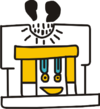Iztacalco
| Iztacalco | ||
|---|---|---|
| Delegación | ||

View of the former San Matías monastery
|
||
|
||
 Iztacalco within the Federal District |
||
| Coordinates: 19°23′43″N 99°05′52″W / 19.39528°N 99.09778°WCoordinates: 19°23′43″N 99°05′52″W / 19.39528°N 99.09778°W | ||
| Country | Mexico | |
| Federal entity | D.F. | |
| Established | 1928 | |
| Named for | Pre-Columbian city | |
| Seat | Río Churubusco y Avenida Té. Col. Ramos Millán | |
| Government | ||
| • Jefe delegacional | Aurelio Alfredo Reyes García (PRD) | |
| Area | ||
| • Total | 23.17 km2 (8.95 sq mi) | |
| Elevation | 2,242 m (7,356 ft) | |
| Population 2010 | ||
| • Total | 384,326 | |
| • Density | 17,000/km2 (43,000/sq mi) | |
| Time zone | Central Standard Time (UTC-6) | |
| • Summer (DST) | Central Daylight Time (UTC-5) | |
| Postal codes | 08000 – 08930 | |
| Area code(s) | 55 | |
| Website | http://www.iztacalco.df.gob.mx | |
Iztacalco (![]() ista'kalco ) is one of the 16 delegaciones (boroughs) into which Mexico's Federal District is divided. It is located in the center-east of the district and is the smallest of the city’s boroughs. The area’s history began in 1309 when the island of Iztacalco, in what was Lake Texcoco, was settled in 1309 by the Mexica who would later found Tenochtitlan, according to the Codex Xolotl. The island community would remain small and isolated through the colonial period, but drainage projects in the Valley of Mexico dried up the lake around it. The area was transformed into a maze of small communities, artificial islands called chinampas and solid farmland divided by canals up until the first half of the 20th century. Politically, the area has been reorganized several times, with the modern borough coming into existence in 1929. Today, all of the canals and farmland are dried out and urbanized as the most densely populated borough and the second most industrialized.
ista'kalco ) is one of the 16 delegaciones (boroughs) into which Mexico's Federal District is divided. It is located in the center-east of the district and is the smallest of the city’s boroughs. The area’s history began in 1309 when the island of Iztacalco, in what was Lake Texcoco, was settled in 1309 by the Mexica who would later found Tenochtitlan, according to the Codex Xolotl. The island community would remain small and isolated through the colonial period, but drainage projects in the Valley of Mexico dried up the lake around it. The area was transformed into a maze of small communities, artificial islands called chinampas and solid farmland divided by canals up until the first half of the 20th century. Politically, the area has been reorganized several times, with the modern borough coming into existence in 1929. Today, all of the canals and farmland are dried out and urbanized as the most densely populated borough and the second most industrialized.
Although the borough is completely urbanized, there are still traces of the area’s rural past, especially in the historic center, which corresponds to the original island in the former Lake Texcoco. This zones is still divided into six neighborhoods called barrios: Santa Cruz, La Asunción, San Miguel, Los Reyes, Zapotla, San Francisco Xicaltongo y Santiago, along with an area called Santa Anita Zacatlalmanco Huéhuetl. Most of these lie along the Calzada de la Viga. This area was designated as a "Barrio Mágico" by the city in 2011.
...
Wikipedia

